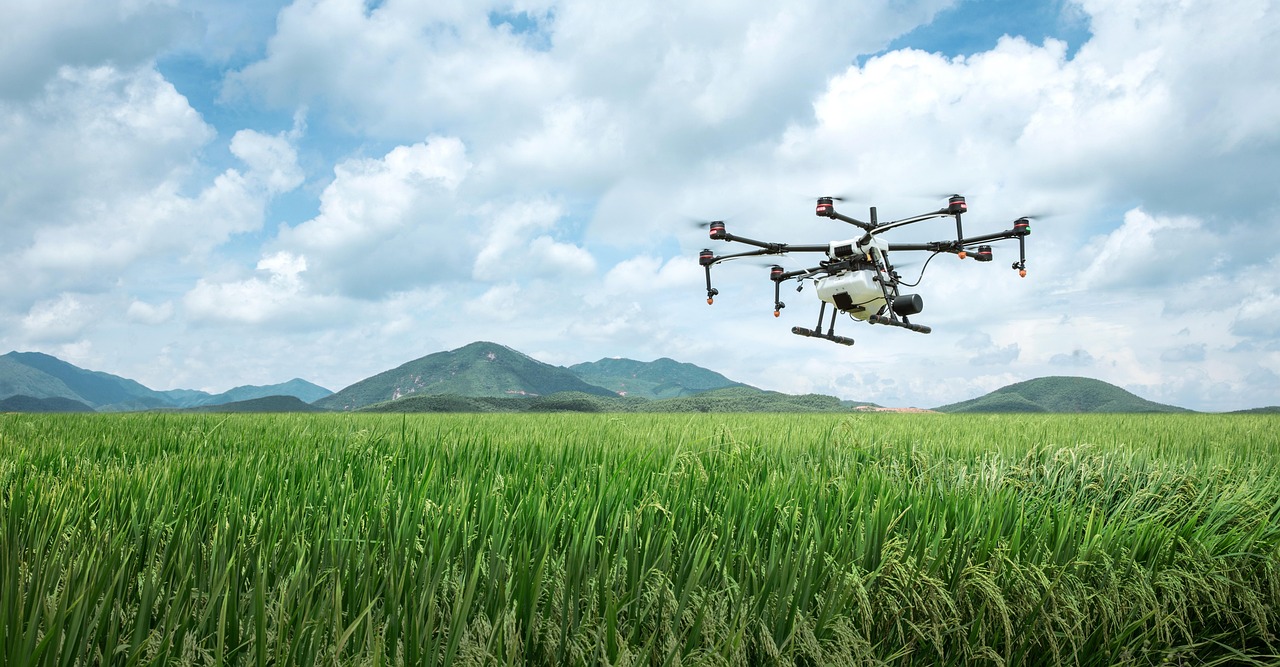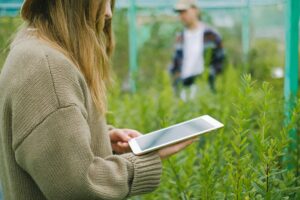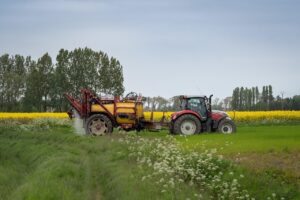How AI is Used in Agriculture: Smart Farming Explained
Introduction: The Rise of Smart Farming
In 2025, agriculture looks drastically different than it did a decade ago. From self-driving tractors to crop monitoring drones and intelligent irrigation systems, artificial intelligence (AI) is reshaping how we grow, manage, and harvest food. This transformation—known as smart farming—uses AI to optimize every stage of agricultural production, improving yield, reducing waste, and enabling more sustainable practices.
Let’s explore how AI is used in agriculture, key tools driving this revolution, and the real-world impact on farmers and food systems.
Table of Contents
-
What is Smart Farming?
-
How AI is Transforming Agriculture
-
Top Use Cases of AI in Agriculture
-
Benefits of AI-Powered Farming
-
Challenges & Limitations
-
Future Trends in AI and Agriculture
-
Final Thoughts
1. What is Smart Farming?
Smart farming, also called precision agriculture, refers to the use of technologies like AI, IoT, robotics, and data analytics to monitor and manage agricultural operations more efficiently. AI plays a central role by analyzing large datasets to help farmers make better decisions about planting, irrigation, pest control, and harvesting.
Instead of relying on tradition or intuition, farmers now use AI-powered tools that learn patterns from soil data, satellite imagery, weather forecasts, and crop health to recommend precise actions.
2. How AI is Transforming Agriculture
A. AI-Powered Sensors & IoT Devices
Sensors embedded in the soil, weather stations, and drones continuously collect data about soil health, temperature, moisture levels, and air quality. AI systems process this data in real time to offer actionable insights, such as when to irrigate or apply fertilizers.
B. Predictive Analytics for Yield Forecasting
AI models use historical data and current field conditions to predict crop yields accurately. This helps farmers plan their logistics, marketing, and supply chain strategies better.
C. Automated Farm Machinery
Tractors and harvesters are now equipped with computer vision and AI, enabling autonomous operation. These machines can identify crops, adjust their behavior based on terrain, and perform tasks like sowing, spraying, and harvesting with precision.
D. AI in Livestock Monitoring
AI-driven facial recognition systems and biometric sensors track livestock health, activity, and feeding patterns. Early disease detection using AI reduces animal mortality and boosts productivity in dairy and meat industries.
3. Top Use Cases of AI in Agriculture
Here are some of the most impactful real-world applications:
1. Crop and Soil Monitoring
AI systems can detect subtle changes in plant health using satellite and drone imagery. Tools like Plantix and Taranis identify diseases, nutrient deficiencies, and pest infestations before the human eye can spot them.
2. Precision Irrigation
AI-based irrigation systems, such as those offered by Prospera or CropX, automatically control water flow based on soil moisture levels, reducing water waste and optimizing plant hydration.
3. Pest and Disease Prediction
AI tools analyze climate data, pest migration trends, and crop health to predict outbreaks. For example, PEAT’s Plantix helps farmers identify plant diseases through smartphone images and suggests treatment options.
4. Smart Harvesting
Robots powered by AI can now harvest fruits and vegetables with precision, reducing human labor costs. Agrobot and Octinion are companies leading this change with strawberry and apple-picking robots.
5. AI in Supply Chain Optimization
AI helps forecast demand and optimize post-harvest logistics, reducing food waste. Platforms like Agremo and GrainChain use blockchain and AI to streamline transactions between farmers and distributors.
6. Livestock Health Management
Wearables and AI software monitor animal vitals in real time. Solutions like Connecterra’s Ida use machine learning to detect early signs of illness or reproductive readiness.
7. Weather Forecasting for Farm Planning
AI-enhanced meteorological tools provide hyper-local weather forecasts to help farmers plan seeding, spraying, and harvesting with better timing and reduced risk.
4. Benefits of AI-Powered Farming
Here’s how AI is improving modern agriculture:
✅ Increased Crop Yield
With data-driven insights, farmers can optimize planting schedules, irrigation, and fertilizer use, leading to higher productivity.
✅ Reduced Resource Usage
AI helps minimize overuse of water, pesticides, and fertilizers, which is better for the environment and lowers production costs.
✅ Early Risk Detection
From pests to droughts, AI detects potential risks earlier than traditional methods, preventing crop failure and livestock disease outbreaks.
✅ Lower Labor Costs
Autonomous machinery reduces the need for manual labor in tasks like harvesting, planting, and monitoring.
✅ Sustainable Agriculture
AI promotes environmentally friendly farming by minimizing chemical use and conserving resources, aligning with global climate goals.
5. Challenges & Limitations of AI in Agriculture
Despite its potential, AI adoption in agriculture faces certain obstacles:
❌ High Initial Costs
Many AI tools, especially drones and autonomous tractors, require significant investment, which is unaffordable for small-scale farmers.
❌ Data Quality & Connectivity
AI’s accuracy depends on high-quality, real-time data. Many rural farms lack reliable internet or infrastructure to support these systems.
❌ Technical Literacy
Farmers in developing regions may struggle with using digital tools or interpreting AI-generated insights without training.
❌ Ethical and Privacy Concerns
Farm data, especially when shared with agri-tech corporations, raises questions around data ownership and privacy.
6. Future Trends in AI and Agriculture
🌾 AI + Drones + Blockchain
Combining AI with blockchain can ensure transparency in supply chains, while drones gather real-time field intelligence.
🌍 Climate-Resilient Farming
AI will play a key role in developing climate-adaptive agriculture by helping identify the best crops for changing weather patterns.
📈 AI for Carbon Tracking
AI models are being developed to track carbon emissions and soil carbon sequestration, helping farmers earn carbon credits.
🧠 Generative AI for Farm Advisory
Like ChatGPT, new AI tools will act as virtual farm consultants, offering 24/7 support via smartphones and voice commands in regional languages.
7. Final Thoughts: Will AI Be the Future of Farming?
The integration of AI in agriculture is not just a trend—it’s a necessity. With the global population projected to hit 10 billion by 2050 and climate change threatening food security, AI-driven smart farming offers a way forward.
By automating time-consuming tasks, optimizing inputs, and offering predictive insights, AI allows farmers to do more with less. While challenges remain in affordability and infrastructure, continuous innovation and policy support are bridging the digital divide.
Smart farming doesn’t replace the farmer—it empowers them. With AI in their hands, farmers can make better decisions, protect the planet, and ensure a stable food supply for generations to come.
AI in Smart Irrigation and Water Management
Water is one of the most critical resources in agriculture, and efficient water use is essential, especially in regions prone to drought or water scarcity. AI-powered smart irrigation systems are revolutionizing how farmers manage water usage.
These systems use data from soil moisture sensors, weather forecasts, and plant water requirements to determine the optimal amount of water needed for each crop. For instance, platforms like CropX and Prospera provide AI-driven insights to schedule irrigation, reducing water wastage by up to 30%.
Benefits:
-
Precision watering reduces costs
-
Prevents over-irrigation and under-irrigation
-
Reduces environmental impact on surrounding ecosystems
AI-Driven Soil Monitoring and Health Analysis
Soil is the foundation of farming, and AI tools are helping monitor and analyze its health more effectively than ever. AI can assess soil composition, pH levels, nutrient content, and microbial activity using a combination of sensors, satellite data, and machine learning algorithms.
Tools like Teralytic and Arable provide farmers with real-time soil diagnostics. AI helps generate actionable insights such as when to apply fertilizers, what kind to use, and where deficiencies may affect yields.
Real-World Use Case:
In India, AI-powered soil testing tools have helped smallholder farmers increase productivity by identifying the right fertilization mix for their specific soil types.
AI in Weather Forecasting and Climate Resilience
Accurate weather forecasting is vital in agriculture, where weather anomalies can destroy entire harvests. AI models can analyze historical and real-time meteorological data to provide more accurate forecasts.
Companies like The Climate Corporation and IBM’s The Weather Company leverage AI for hyper-local weather predictions. These forecasts are critical for scheduling planting, irrigation, and harvesting—especially in areas affected by climate change.
Example:
AI systems can predict an incoming frost several days in advance, allowing farmers to take preventive measures such as using frost blankets or delaying harvest.
Pest and Disease Detection with Computer Vision
Crop pests and diseases are responsible for huge losses in agricultural production globally. AI-powered image recognition tools and drones equipped with computer vision systems help identify these threats early.
Applications such as Plantix and PEAT use smartphone cameras to capture leaf images and compare them to a database of diseases and pest infestations. Drones with multispectral imaging can scan vast fields for signs of pest infestations invisible to the naked eye.
Benefits:
-
Early detection minimizes damage
-
Reduces the need for widespread pesticide use
-
Protects crop yields and food safety
AI in Automated Harvesting and Robotics
Labor shortages and rising costs have accelerated the adoption of AI-enabled robotics in harvesting. These smart machines use sensors, cameras, and AI algorithms to identify ripe produce and pick them without damaging the plant.
Examples include:
-
Blue River Technology: Uses AI in lettuce thinning and cotton harvesting.
-
Octinion’s Rubion Robot: Can pick strawberries as gently as a human hand.
-
Agrobot: Uses 3D vision and AI to harvest fruit.
These technologies are especially useful in high-labor crops like strawberries, tomatoes, and grapes.
Supply Chain Optimization and Market Forecasting
AI doesn’t stop at the farm—it also revolutionizes post-harvest operations. AI tools are used in predicting demand, optimizing logistics, and even setting dynamic pricing based on supply-demand metrics.
For instance, platforms like AgriDigital and IBM Food Trust use blockchain combined with AI to trace produce from farm to fork. This ensures transparency, reduces spoilage, and helps in quality control.
AI can also predict market trends and demand patterns, allowing farmers to make better decisions about what to grow and when to sell.
AI in Livestock Monitoring
AI is also transforming animal husbandry. Smart wearables and facial recognition for livestock are now possible. AI tools track feeding, sleeping, movement, and health symptoms of animals.
Tools like Connecterra’s Ida and Cowlar offer farmers dashboards that flag abnormal behavior, predict disease outbreaks, and optimize feeding schedules. AI is even used in selective breeding by analyzing genetic data for desirable traits.
Benefits:
-
Prevents disease outbreaks
-
Increases productivity and milk yield
-
Enhances animal welfare
AI-Powered Farm Management Platforms
AI is at the core of modern Farm Management Systems (FMS), integrating various data sources into a centralized dashboard. These platforms provide end-to-end visibility on operations—from planting to selling.
Examples include:
-
John Deere’s Operations Center
-
Granular by Corteva
-
Trimble Ag Software
These tools help manage finances, track inventory, automate reporting, and create predictive models based on weather, yield, and market prices.
AI for Sustainable and Climate-Smart Agriculture
As climate change affects farming ecosystems, AI tools are aiding in sustainability efforts by reducing carbon footprints, managing biodiversity, and ensuring responsible land use.
For example:
-
AI algorithms optimize fertilizer usage to avoid nitrogen runoff into water bodies.
-
AI-driven crop rotation models preserve soil health and avoid monocultures.
-
AI can suggest cover cropping and conservation tillage practices.
Many AI startups and NGOs are now focused on “climate-smart agriculture,” where food production is enhanced without harming the environment.
Challenges of AI Adoption in Agriculture
Despite the benefits, several challenges still slow down AI adoption in agriculture:
1. Cost and Accessibility: Many AI tools are expensive and may not be feasible for small farmers without government support or subsidies.
2. Data Quality: AI depends on accurate, consistent data—which may be lacking in developing countries due to poor connectivity and sensor access.
3. Digital Literacy: Farmers need training and support to effectively use AI tools. In rural areas, limited education and language barriers can hinder adoption.
4. Ethical and Privacy Concerns: With so much data collected—from soil to market—issues around data ownership and privacy arise.
Future Outlook: AI as the Backbone of Precision Agriculture
The future of agriculture lies in precision farming, where AI tailors every aspect of production to exact needs. With 5G connectivity, edge computing, and better data availability, AI tools will become more robust and accessible.
Emerging technologies like generative AI are even helping simulate various farming outcomes based on different input conditions—essentially letting farmers “test the future.”
AI will also play a crucial role in:
-
Vertical farming
-
Aquaponics and hydroponics
-
Smart greenhouses
-
Global food security initiatives
Final Thoughts
AI in agriculture is more than a trend—it’s a revolution. From predictive analytics and computer vision to autonomous robots and blockchain-integrated traceability, AI is reshaping every part of the agricultural value chain. It helps increase productivity, reduce costs, preserve the environment, and ensure a stable food supply for future generations.
As AI technology becomes more affordable and accessible, the dream of smart farming will not just be for tech-savvy giants but for every farmer across the globe.
❓FAQs
Q1. What is AI in agriculture?
AI in agriculture refers to the use of artificial intelligence technologies—like machine learning, computer vision, and robotics—to improve farming practices, increase yield, and automate processes.
Q2. What are examples of AI tools in farming?
Examples include:
-
Drones for crop monitoring
-
Smart irrigation systems like CropX
-
AI crop disease identifiers like Plantix
-
Autonomous tractors from John Deere
Q3. Is AI farming affordable for small farmers?
While many AI tools are expensive, low-cost smartphone apps, satellite services, and government subsidies are making smart farming more accessible.
Q4. Can AI help fight climate change in agriculture?
Yes. AI helps reduce resource wastage, promotes sustainable practices, and enables farmers to adapt to changing climates through data-driven decisions.
Q5. What’s the future of AI in agriculture?
The future includes AI-integrated supply chains, predictive crop models, generative AI farm advisors, and carbon tracking for green farming initiatives.
AI in Finance: Opportunities, Risks, and the Road Ahead in 2025
AI in Finance: Revolutionizing the Future of Financial Services





